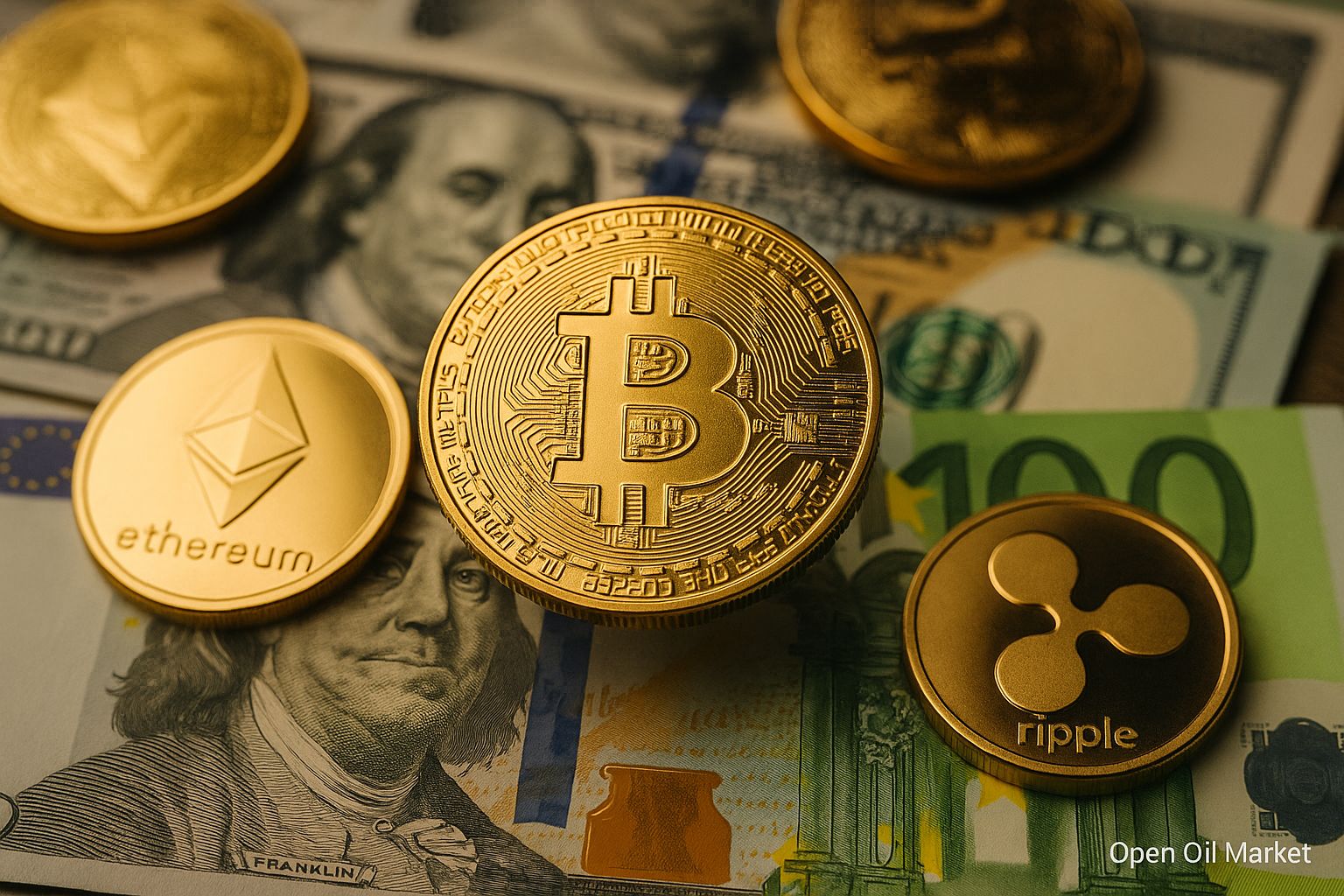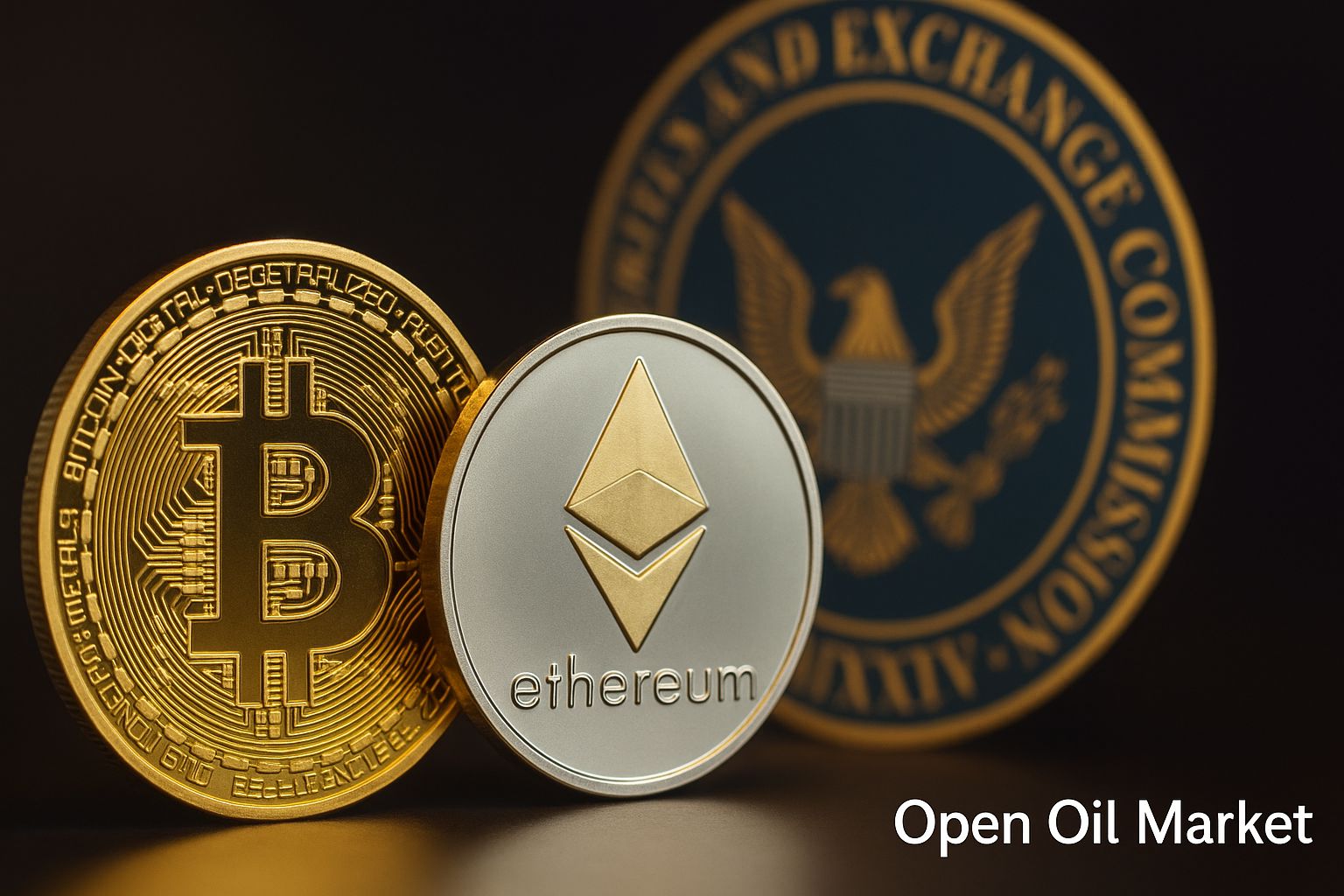
Cryptocurrency News August 3, 2025 — Bitcoin at $113K, ETF on XRP and Institutional Inflow
The cryptocurrency market continues to capture heightened investor interest: Bitcoin is trading near $113,000 after a week of volatile fluctuations, while the industry as a whole shows resilience. Amid the consolidation of major coin prices, there is still a significant influx of institutional capital, and regulators worldwide are introducing new initiatives that could shape the future of the market. Let’s examine the details of the current situation and key news relevant to investors on August 3, 2025.
Cryptocurrency Market: Consolidation Before a New Week
After a rapid rally in July, the cryptocurrency market is experiencing a phase of consolidation at the beginning of August. The total market capitalization of digital assets hovers around $3.8 trillion, just slightly below the recent peak of over $4 trillion. By the end of the week, many investors took profits: all top 10 coins by market capitalization closed Friday trading with slight declines. This downturn is largely attributed to sell-offs at reached highs — Bitcoin's surge to ~$114,000 made this mark a psychological level where some large holders ("whales") exited their positions. An additional external factor was macroeconomic news: reports of new trade tariffs in the US increased global aversion to risk assets, which temporarily impacted cryptocurrencies as well.
Nevertheless, by the weekend, the market stabilized. Daily volatility of Bitcoin and Ethereum noticeably decreased, and quotes moved within narrow ranges. The absence of sharp price swings is seen by participants as a sign of a healthy market: after the tumultuous growth of recent weeks, a natural "digestion" of achieved levels occurs. Investors are anticipating new drivers and keeping an eye on the external environment. The US Federal Reserve, during its meeting at the end of July, maintained the base rate at 4.25%, aligning with expectations and not causing turbulence. However, upcoming publications on inflation data and the annual Fed symposium in Jackson Hole could add volatility and influence risk appetite in the coming weeks. Overall, the sentiment is moderately positive: the market enters the weekend in a state of equilibrium, preparing for the start of a new week.
Bitcoin: Holding Positions Below Historic Highs
The flagship cryptocurrency Bitcoin (BTC) continues to hover close to its record values. After reaching a new all-time high of around $123,000 in mid-July, the price corrected and is now fluctuating in the range of $115–113K. Bulls have yet to confidently surpass the psychological barrier of $120,000 — blockchain data indicates an increase in coin withdrawals by large investors at these levels, suggesting profit-taking. Many short-term holders sold off just after BTC first exceeded $120,000, causing a local pullback.
Meanwhile, the long-term bullish trend of Bitcoin remains intact. Institutional funds and corporations continue to accumulate BTC, anticipating the coin's limited supply and its status as a digital analogue to gold. Analysts at investment bank Bernstein estimate that under favorable circumstances, Bitcoin could reach $150–200K by the end of the year. However, for a new breakout to occur, it needs to firmly establish itself above the previous high. If the influx of capital continues and the macroeconomic backdrop improves (for instance, if inflation slows down and the Fed shifts to easing policy), BTC could have opportunities to reach new heights. Short-term fluctuations and corrections are inevitable, but the overall market sentiment remains bullish thanks to support from major players.
Ethereum: New Attempt at Breaking $4,000
Ethereum (ETH), the second-largest digital asset by market capitalization, displays confident dynamics, although it has yet to overcome a key milestone. In July, ETH’s price surged by approximately 50%, first exceeding the $3,500 mark since spring. By the end of the month, Ethereum approached the psychologically significant level of $4,000, yet encountered selling resistance when nearing ~$3,900. By taking profits, traders prevented an immediate breakout above this level, and by the end of the week, Ethereum fell back to around ~$3,700–3,800, which is still significantly above levels seen at the start of summer.
The fundamental factors for Ethereum remain positive. Institutional investors have actively increased their investments: Ethereum-based exchange-traded funds (ETFs) have seen inflows almost daily over the past few weeks, setting a record for consecutive weeks of investments. The development of Layer 2 solutions and increased activity in DeFi ecosystems also support demand for Ethereum, alleviating the main network and reducing fees. Experts note that a successful breakout above $4,000 will pave the way for ETH to reach its historical high (~$4,800, achieved in 2021). Given favorable market conditions, Ethereum is poised to continue its upward trend, outpacing many altcoins in growth momentum. Investors are closely monitoring upcoming network updates and regulatory decisions regarding Ethereum-ETF applications, which could serve as an additional catalyst for movement.
Top 10 Most Popular Cryptocurrencies
The top ten largest crypto assets by market capitalization currently includes the following coins and tokens:
- Bitcoin (BTC) – approximately $113,000. The first and largest cryptocurrency dominates the market (around 50% of total capitalization) and holds its reached heights. Bitcoin continues to be viewed by investors as "digital gold" and a hedge against inflation, maintaining steady demand.
- Ethereum (ETH) – about $3,750. The largest altcoin (~18% of the market) is strengthening thanks to active development of the smart contract ecosystem and an influx of institutional investments. The immediate goal for Ethereum is a confident breakout above $4,000, supported by the deflationary mechanism of ETH issuance and increased usage of the network.
- Tether (USDT) – ~$1, the leading stablecoin. USDT is pegged to the US dollar 1:1 and provides high liquidity in the crypto market, remaining the primary tool for capital storage between trades. Tether's issuer is expanding its presence in regulated markets, highlighting the growing demand for reliable "digital dollars" in the digital economy.
- Binance Coin (BNB) – ~$770. The proprietary token of the largest cryptocurrency exchange, Binance, recently hit an all-time high amid increased user activity. Despite regulatory pressures in several jurisdictions, BNB maintains its position as one of the leading coins, offering owners privileges on the platform and within the BNB Chain ecosystem.
- XRP (Ripple) – ~$3.10. The token of the Ripple payment network has surpassed $3 for the first time since 2018, reaching multi-year highs. XRP's strengthening is aided by legal clarity in the US following the conclusion of a lengthy court dispute between Ripple and the SEC, as well as expectations surrounding the launch of exchange-traded products based on XRP. The coin is attracting attention from institutional investors as an efficient tool for cross-border settlements.
- USD Coin (USDC) – ~$1, the second-largest stablecoin. The coin issued by the Centre consortium (Circle and Coinbase) is fully backed by reserves in US dollars. USDC is known for its transparency and compliance with regulatory standards, making it a preferred choice for institutional participants, especially in light of new stablecoin legislation.
- Solana (SOL) – ~$175. A promising first-layer blockchain known for its high transaction speeds and low fees is confidently ranking among the market leaders. SOL has shown impressive growth over the past year due to the expansion of the Solana DeFi and NFT ecosystems, as well as rumors about the potential launch of exchange-traded funds for this asset. Investors note significant improvements in network stability after previous technical issues were resolved.
- Cardano (ADA) – ~$0.72. The largest platform utilizing the Proof-of-Stake algorithm is developing based on a scientific approach. Despite the lack of new price records, ADA is steadily maintained in the top ten. In 2025, the Cardano network is experiencing a phase of active growth: new smart contract applications are being implemented, and the community is expanding, which supports investor interest in the coin.
- Dogecoin (DOGE) – ~$0.21. The well-known meme cryptocurrency, originally created as a joke, remains one of the most capitalized coins. After a series of spikes, DOGE's price is correcting, but the coin still enjoys demand thanks to its loyal community and periodic support from influential figures. The volatility of Dogecoin continues to depend on hype on social media; however, in general, the dynamics of DOGE follow the trends of the altcoin market.
- TRON (TRX) – ~$0.34. A platform for smart contracts and decentralized services founded by entrepreneur Justin Sun has entered the ranks of the top ten largest crypto assets. TRX recorded a several percent gain this week, distinguishing itself amid the relative stagnation of several other altcoins. The Tron network attracts users with low fees and is widely used for launching stablecoins and tokenization, which maintains interest in the token.
Altcoin Growth: XRP, BNB, Solana, and Others
The alternative cryptocurrency (altcoin) segment has shown mixed dynamics in recent days. Several leading coins have managed to retain earlier gains or continue growing, while others have transitioned to moderate correction. The main newsmaker remains XRP, whose rally has become one of the summer's most prominent events: Ripple's token is maintaining levels above $3, confirming a return of investor confidence after years of uncertainty. Positive regulatory news and the prospect of exchange-traded products based on XRP are supporting interest in this asset. Another beneficiary of the market is Binance Coin (BNB), which has set a new all-time high in value. The rise of BNB is due to both the overall market surge and the high activity on the Binance exchange and its associated services. Investors highly value BNB's role in the ecosystem of the world's largest crypto platform.
Other significant altcoins are also attracting capital, although their movements vary. Solana (SOL) is retaining much of its previously gained positions after an impressive leap in the first half of the year: the current price around $175 reflects investors' confidence in the technical potential of the Solana network. TRON (TRX) grew several percent over the past week due to increased transactional activity within the network and expanded use of stablecoins in the Asian region. At the same time, a number of large altcoins have experienced slight corrections, such as Cardano and Dogecoin, which have retreated from their local peaks previously reached in the summer. Nevertheless, overall interest in altcoins remains strong. Projects with actively developing ecosystems and prospects for launching ETFs are especially sought after. Expectations for the imminent appearance of exchange-traded funds on XRP, Solana, and even some meme cryptocurrencies fuel forecasts for a new "altseason" in the coming months.
Regulation: Global Initiatives and Industry Support
The regulatory environment surrounding cryptocurrencies in 2025 is undergoing significant changes, as authorities in various countries increasingly set unified rules for the market. In the United States, a comprehensive package of measures for overseeing stablecoins has been adopted at the federal level for the first time. The law signed by President Donald Trump (informally referred to as the Genius Act) took effect in July and requires issuers of dollar-pegged stablecoins to back their coins with reserves of liquid assets at 100%, as well as undergo regular audits. This step aims to protect investors and enhance trust in the stablecoin sector. Simultaneously, Congress is advancing a broad legislative initiative to regulate the entire cryptocurrency market, striving to create a legal framework for trading digital assets. Lawmakers and officials are becoming increasingly favorable toward the industry: the new administration is fulfilling its promise to make the US the "crypto capital of the world," softening its supervisory approach. The Securities and Exchange Commission (SEC), under the leadership of Paul Atkins, has shifted its course toward collaboration with the market. The SEC has developed criteria for determining tokens as securities and updated ETF listing rules, allowing the launch of ETFs on crypto assets that have traded futures for at least 6 months. This innovation effectively opened the door for spot ETFs for several leading altcoins to emerge this autumn — analysts estimate the probability of such products being approved (on XRP, Solana, Litecoin, and even Dogecoin) at 60–90%. It is expected that the regulator's first decisions on these applications will be made in September–October 2025.
The shift in regulatory course in the US is accompanied by concrete actions. The SEC, under the new administration, has withdrawn several lawsuits against major crypto exchanges initiated by the previous leadership, eliminating significant uncertainty for the market. Additionally, at the end of July, the White House published the first strategy on digital assets — a report from the presidential working group explicitly urged financial authorities to accelerate the integration of cryptocurrencies into the national system. These events have served as powerful positive signals for the industry. Similar trends are forming in other parts of the world. In the European Union, the MiCA (Markets in Crypto-Assets) regulations came into effect, introducing transparent rules for the issuance of crypto assets, the operation of crypto exchanges, and wallet providers across all EU countries. This allows companies to operate legally in the European market and obtain standardized licenses. In Asia, financial hubs such as Hong Kong and Singapore are competing for the title of leading crypto hub, offering specialized regulatory regimes and tax incentives for blockchain businesses. In the Gulf countries (UAE, Bahrain, Saudi Arabia), authorities are also implementing initiatives to attract cryptocurrency companies and develop the Web3 sector. The global trend is clear: governments are attempting to integrate cryptocurrencies into the existing financial system through understandable rules. In the long run, this reduces legal risks for investors and opens new opportunities for large institutions wishing to engage with digital assets.
Institutional Investments Hit Record Highs
Large investors continue to increase their presence in digital assets at unprecedented rates. According to a recent report from analytics firm CoinShares, cryptocurrency funds attracted approximately $11 billion in total in July — a record monthly inflow in history. This amount significantly exceeded the previous high and reflects steady interest from financial institutions. Weekly inflows into cryptocurrency ETPs and trusts have been recorded every week for the past three months, leading to aggregate assets under management (AUM) in the industry reaching a new peak of over $220 billion. For comparison, this figure was considerably lower at the beginning of the year; the rapid growth highlights how quickly crypto investments have become mainstream for institutions.
A remarkable feature of the latest wave of investments has been a shift in focus toward altcoins. According to CoinShares, funds based on Ethereum have become the weekly leaders, receiving nearly $1.6 billion in inflows over seven days (the second-largest weekly result in history). Since the beginning of the year, investments in Ethereum products have exceeded $7.7 billion, surpassing the total for 2024. At the same time, Bitcoin-oriented funds recorded a slight outflow (~$175 million for the week) — the first such outflow in a long time. Analysts see this as a sign of the emerging "altseason," where major players diversify their portfolios beyond BTC in search of higher returns. Products based on Solana and XRP have also gained popularity, attracting ~$300 million and ~$190 million, respectively, amid expectations for the launch of spot ETFs and increased confidence in these networks. Meanwhile, traditional altcoins from previous cycles (such as Litecoin and Bitcoin Cash) have experienced minor outflows, indicating a selective approach: capital is primarily flowing into projects considered most promising and ready for institutional acceptance.
The increase in institutional interest is also evident in the actions of the largest asset managers. Companies such as BlackRock and Fidelity submitted applications in July for the launch of spot Bitcoin ETFs and Ethereum ETFs, which are currently under review by regulators. Experts expect that approval for these products could occur in the coming months, providing access to the cryptocurrency market for even more conservative investors through familiar exchange-traded instruments. Furthermore, an increasing number of public companies are adding Bitcoin to their treasury reserves as a long-term strategic asset, reinforcing BTC's status as a protective instrument in the corporate sector. Overall, the ongoing institutionalization of the industry serves as a foundation for further growth: the more large capital enters the market, the higher the liquidity and price stability, as well as the trust of the broader financial community.
Major Investors and Companies in the Crypto Market
The growing legitimacy of cryptocurrencies is reinforced by news about the steps taken by renowned corporations and investors in this sphere. Key economic players are increasingly engaging with digital assets, setting a positive tone for the entire market. Below are some notable examples from recent days:
- Visa announced the expansion of its international payment program using stablecoins. The payment network is launching partnerships with crypto firms for cross-border transfers via USD Coin (USDC) in Ethereum and Solana networks, aiming to reduce costs and speed up settlements. The participation of Visa — one of the world leaders in payments — demonstrates the rapid adoption of blockchain technology in traditional finance.
- Deutsche Bank has obtained the appropriate license and launched a digital asset custody and trading service for institutional clients. One of Europe's largest banks is now officially offering major investors services related to cryptocurrencies compliant with regulatory requirements. This initiative reflects the growing demand from traditional financial institutions for safe ways to interact with this new class of assets.
- London Stock Exchange Group (LSEG) made strategic investments in a digital asset trading platform. The owner of the London Stock Exchange acquired a stake in a crypto exchange, planning to integrate trading in tokenized financial instruments into its ecosystem. This merger of the traditional stock market with the cryptocurrency industry emphasizes the blurring of boundaries between them and indicates the readiness of the largest exchanges to adapt to the changing financial landscape.
Such steps by media corporations, banks, and tech giants strengthen confidence in the crypto market. While digital assets were once primarily viewed by enthusiasts and specialized funds, players from Wall Street and international companies are now joining in. This forms a new level of legitimacy and will likely lead to further inflows of capital from adjacent sectors of the economy.
Infrastructure and Technology: Mining and DeFi Integration
Concurrent with the influx of investment, the infrastructure of the crypto industry continues to develop. Significant changes are occurring in the mining sector: the largest manufacturers and operators are seeking to relocate their operations to regions with favorable conditions. For example, the Chinese company Bitmain plans to open an ASIC mining factory in the US by early 2026. This step coincides with the Trump administration's course on localizing high-tech business: US authorities previously announced the creation of favorable conditions for miners, including tax incentives and customs duties, encouraging the relocation of equipment from Asia. Strengthening the US position as a global crypto mining hub reduces geopolitical risks in the industry and diversifies Bitcoin's hash rate distribution across different countries.
The infrastructure for retail services is also advancing. Major fintech platforms are integrating cryptocurrency capabilities into their products. Recently, PayPal expanded the functionalities of its Pay with Crypto service, allowing millions of users worldwide to send and receive cryptocurrency with minimal fees and convert it into fiat within the app. The popular cryptocurrency wallet MetaMask, which has surpassed 100 million addresses, implemented the Stablecoin Earn feature for generating passive income: now holders of stablecoins (USDT, USDC, DAI) can deposit their funds for interest directly through integration with decentralized protocols and use the MetaMask debit card for everyday expenses directly from their crypto account. Such innovations blur the line between traditional finance and decentralized services, making the use of cryptocurrencies more convenient for a broad audience.
The implementation of new technologies and infrastructure development make the cryptocurrency ecosystem more mature. Increasing the reliability of services, establishing local equipment production, and integrating DeFi platforms into familiar applications contribute to further mass adoption of crypto assets. In the long run, improved infrastructure will enhance trust from both private and institutional users, positively impacting the stability and liquidity of the digital currency market.
Prospects and Expectations
As of early August 2025, the cryptocurrency market demonstrates both maturity and potential for new growth. Bitcoin continues to hover near all-time highs, indicating that the previous surge has been successfully absorbed by the market and investors are ready for further challenges. The unprecedented inflow of institutional capital and the increasing engagement of major players provide an upward momentum that may continue in the second half of the year. At the same time, active participation from regulators — from the US to Europe and Asia — reduces uncertainty and lays the groundwork for broader cryptocurrency adoption in the global economy.
Undoubtedly, high volatility remains a characteristic feature of crypto assets. The market remains sensitive to news and macroeconomic factors. Investors will closely monitor signals from central banks and governments: for instance, any hints at easing monetary policy or, conversely, sudden restrictions could significantly affect risk appetite. Positive industry events, such as a final resolution of legal issues (like the Ripple case) or approval of anticipated crypto ETFs, could provide the market with a new bullish impulse. Conversely, possible negative surprises in the macro arena or harsh regulatory actions may temporarily dampen enthusiasm.
However, the overall development vector appears encouraging. Cryptocurrencies are increasingly integrating into the traditional financial system, ceasing to be a niche experiment and evolving into a full-fledged investment asset class. For investors from the CIS countries and the world, this means the emergence of new opportunities for diversification and capital protection. Bitcoin and Ethereum are increasingly included in balanced portfolios, and the emergence of new instruments (such as spot ETFs on various coins) will facilitate broader market access for a wide range of participants. If current trends persist, further increases in trust in the sector, the launch of new products, and new capital inflows from adjacent sectors can be expected in the second half of 2025. Cautious optimism prevails: the crypto market is entering the next phase of development, ready to leverage emerging opportunities while remaining aware of the risks inherent in this nascent high-tech field.




